Table of contents
- Who was Adolf Hitler?
- Related Toys
- Minifigure – Adolf Hitler with a brown uniform and cap
- Minifigure – Adolf Hitler with grey uniform and cap
- Minifigure – Adolf Hitler with with grey uniform and black hair
- Minifigure – Adolf Hitler with a white uniform and cap
- Minifigure – Adolf Hitler with a brown uniform and hair
- Minifigure – Adolf Hitler with formal uniform
- Minifigure – Adolf Hitler wearing reading glasses
- Minifigure – Young Adolf Hitler
- How did Adolf Hitler die?
- How old was Adolf Hitler when he died?
- How old would Adolf Hitler be today?
- When and where was Adolf Hitler born?
- What did Adolf Hitler do?
- Did Adolf Hitler have children?
- How did Adolf Hitler rise to power?
- How tall is Adolf Hitler?
- How did Adolf Hitler kill the jews?
- How did Adolf Hitler find a wife?
- How many people did Adolf Hitler kill?
- When and how did Adolf Hitler come to power in Germany?
- Why did Adolf Hitler hate jews?
- Why did Adolf Hitler start WW2?
- What did Adolf Hitler do in ww2?
- Was Adolf Hitler Jewish?
- How many assassination attempts were there on Adolf Hitler?
- What Religion was Adolf Hitler?
- Where is Adolf Hitler from?
- What was Adolf Hitler’s real name?
- Is it illegal to name your kid Adolf Hitler?
- What is Adolf Hitler known for?
- Is Adolf Hitler a good leader?
- Does Adolf Hitler have any living relatives?
- Was Adolf Hitler a dictator?
- Was Adolf Hitler a good person?
- Was Adolf Hitler a vegetarian?
- Was Adolf Hitler gay?
- What country did Adolf Hitler lead?
- What did Adolf Hitler look like?
Hey everyone, have you ever noticed just how many toys there are based on Adolf Hitler? A significant number of them are LEGO minifigures!
Lately, a lot of new friends I’ve made have been really curious to learn more about Adolf Hitler. So, I’ve decided to use this article to help everyone get familiar with some background information on him and to answer many of the common questions people have about this historical figure.
More importantly, this article will also serve as a hub. I’ll be showcasing many of the review roundup posts I’ve written covering corresponding Adolf Hitler toys, LEGO minifigures, and some LEGO alternatives. These articles provide highly detailed breakdowns with both pictures and text. On top of that, within those roundup posts, I also make it a point to recommend articles from other friends and reviewers who have covered these same toys!
Of course, in addition to the review posts, I’ll also be recommending a lot of interesting toys related to Adolf Hitler.
Without further ado, let’s get started!
Who was Adolf Hitler?
Adolf Hitler (1889–1945) was an Austrian-born German politician who became the dictator of Germany from 1933 until his death in 1945. He rose to power as the leader of the National Socialist German Workers’ Party (NSDAP), commonly known as the Nazi Party. After being appointed Chancellor in 1933, he rapidly dismantled Germany’s democratic republic and established a totalitarian dictatorship known as the Third Reich, centralizing power around himself as the Führer (Leader). His rule was based on the fascist ideology of Nazism, which promoted extreme German nationalism, virulent antisemitism, and anticommunism.
Hitler is the central figure responsible for initiating World War II in Europe with the invasion of Poland in September 1939. He was also the primary architect of the Holocaust, the state-sponsored, systematic genocide of six million Jews and millions of other victims, including Romani people, Poles, Soviet prisoners of war, people with disabilities, and political opponents. His regime’s brutal actions and expansionist military campaigns led to the deaths of tens of millions of people, making the war the deadliest conflict in human history. He died by suicide in his Berlin bunker on April 30, 1945, as the Third Reich collapsed.
Related Toys
Before we get into the history, take a look at the Adolf Hitler figures we have here. They are incredibly faithful recreations. The different uniforms and styles show him at different points in time, which actually makes it easier to get a better grasp of this historical figure. Click here to check all the Adolf Hitler figures.
Minifigure – Adolf Hitler with a brown uniform and cap
Click here to check the product
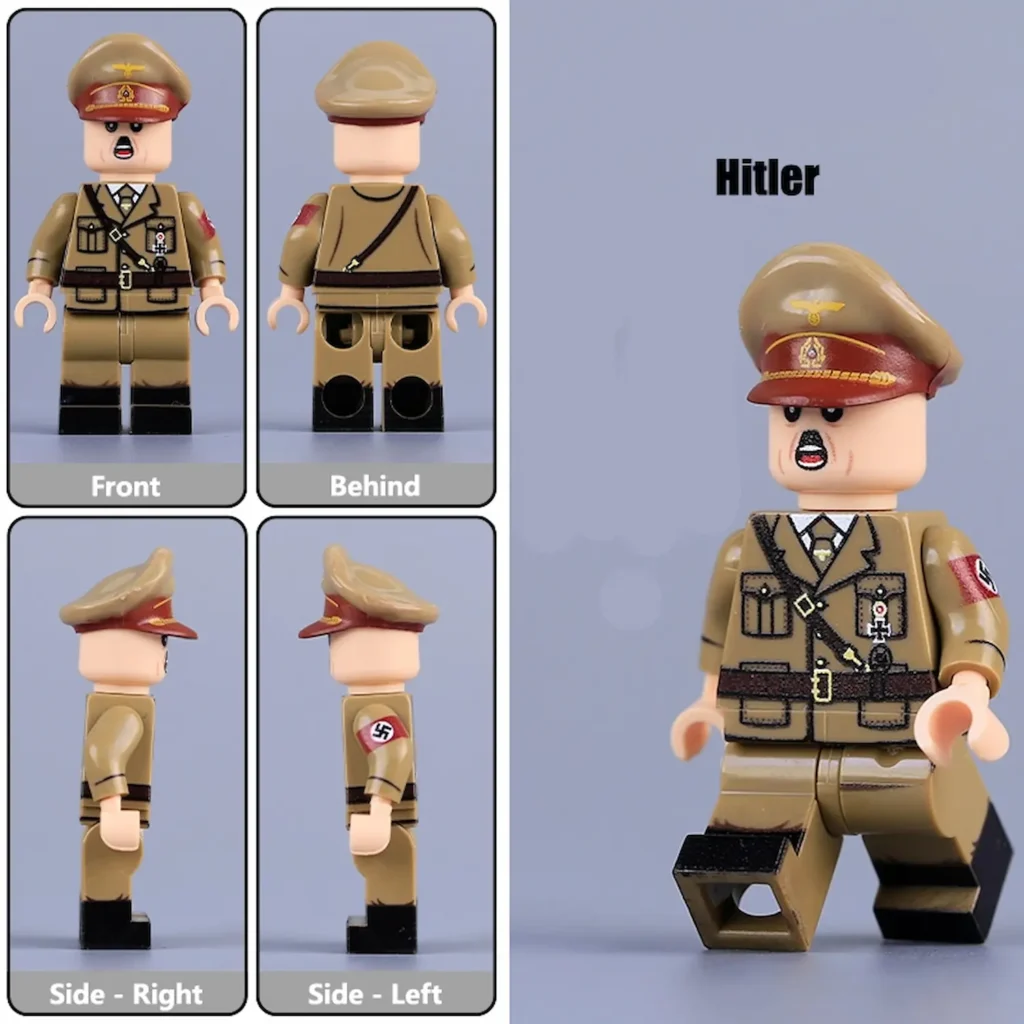
This figure wears the official brown shirt uniform of the Nazi Party (NSDAP), which became famous as the uniform of the SA, or “Brownshirts.”
As the party’s Führer (Leader), Adolf Hitler wore this political uniform frequently during his rise to power in the 1920s and 1930s to symbolize his leadership of the movement, before later adopting military-style gray uniforms during World War II. You can check this article to learn more.
Minifigure – Adolf Hitler with grey uniform and cap
Click here to check the product
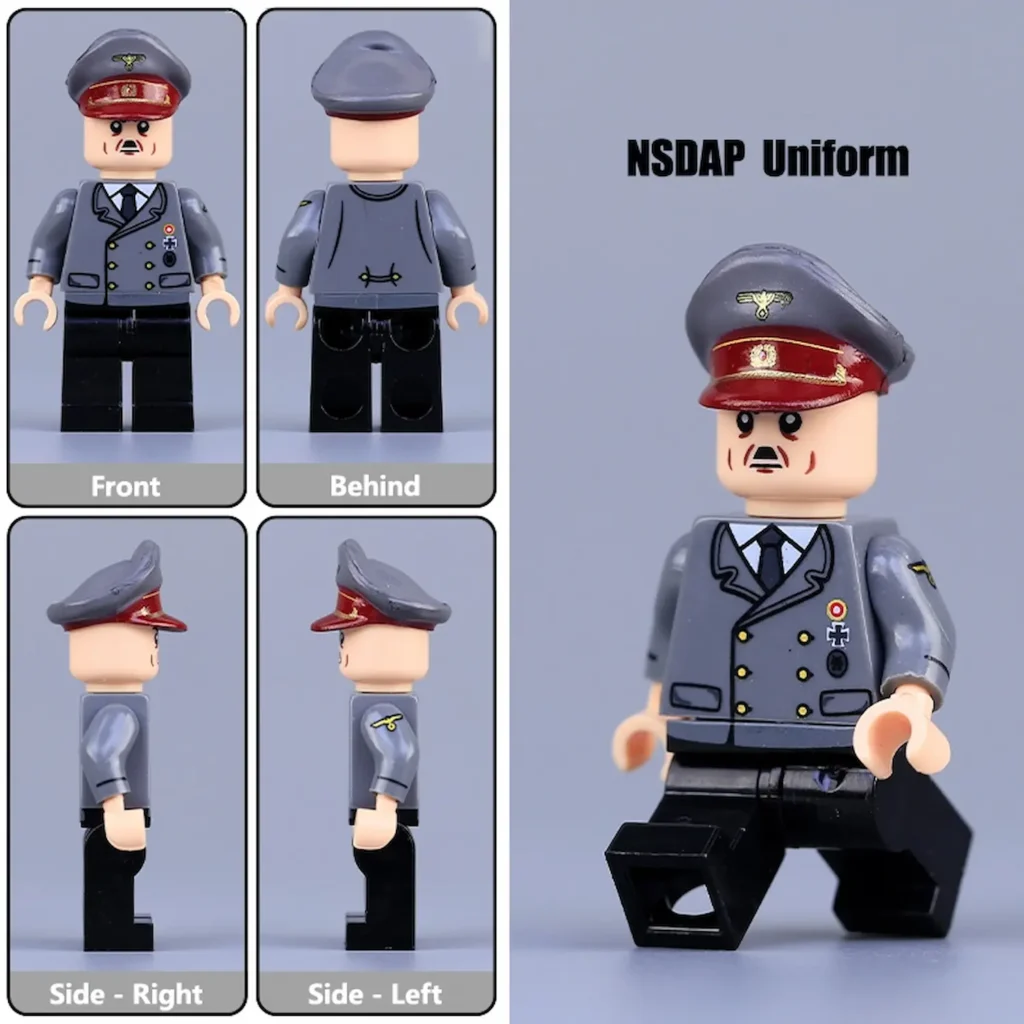
This is the field-gray military-style uniform that Adolf Hitler wore throughout World War II. He adopted it on September 1, 1939, to symbolize his new role as Supreme Commander of the Armed Forces, shifting his public image from a political party leader to Germany’s supreme wartime commander. He wore this uniform almost exclusively until his death in 1945.
Minifigure – Adolf Hitler with with grey uniform and black hair
Click here to check the product
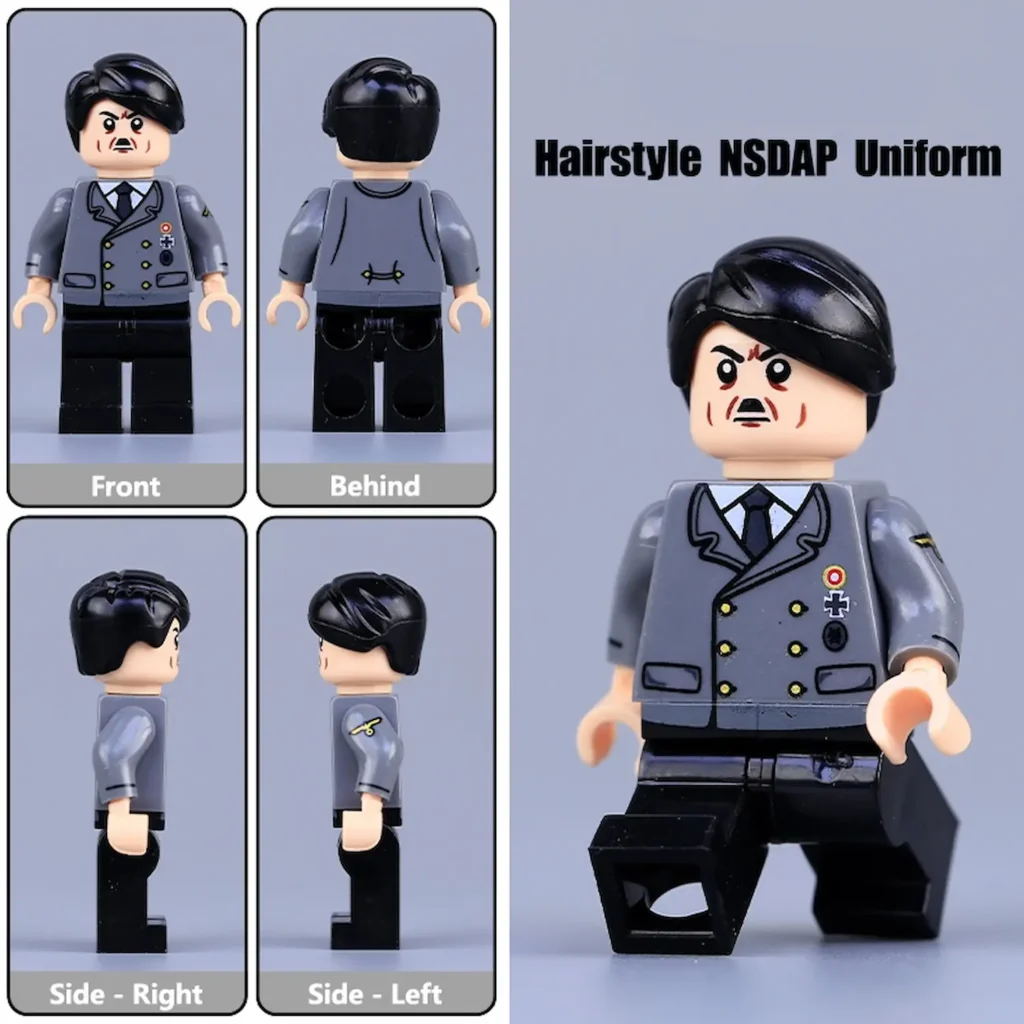
This is Adolf Hitler’s iconic appearance during World War II, showing him in his standard field-gray military uniform but without his peaked cap. This is how he would have looked while indoors at his military headquarters, such as the Führerbunker or the “Wolf’s Lair.”
Minifigure – Adolf Hitler with a white uniform and cap
Click here to check the product
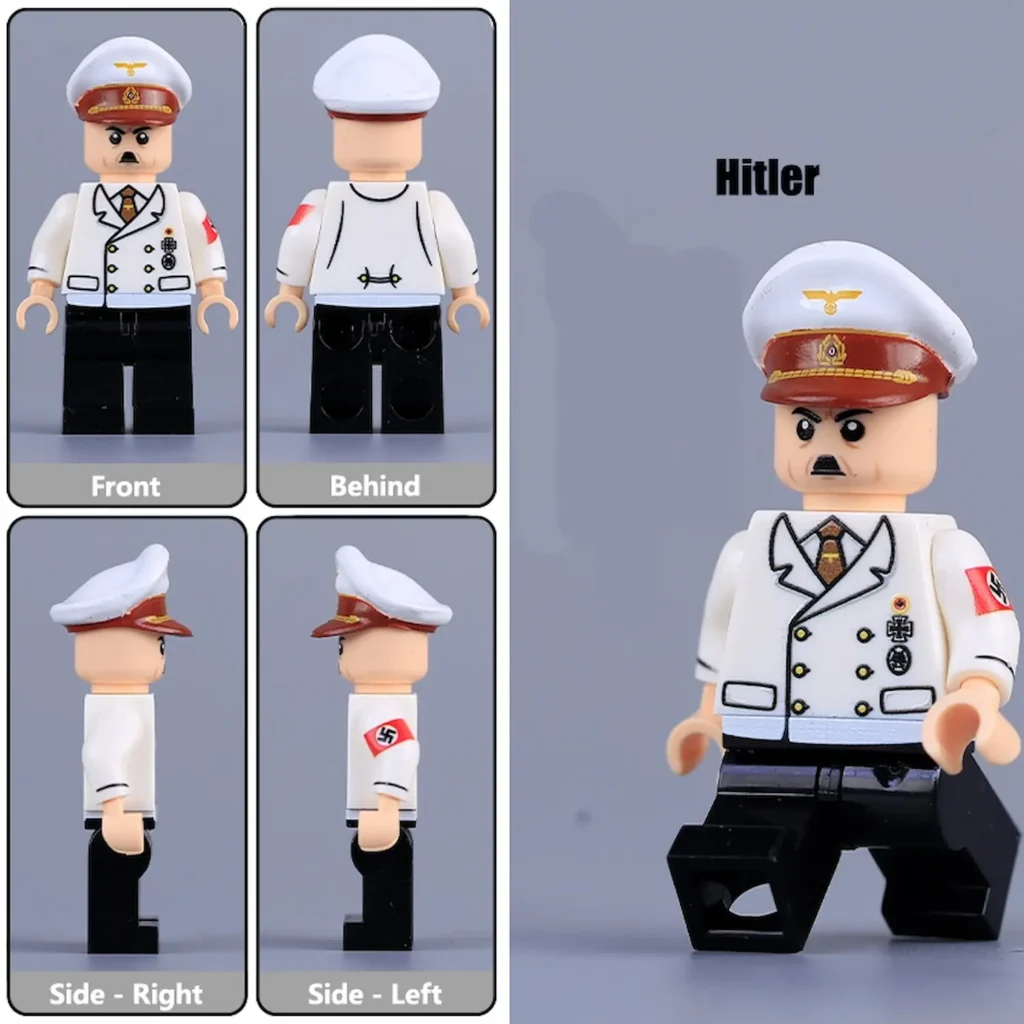
This is Adolf Hitler’s white summer uniform, a formal variation of the Nazi Party uniform. He wore it for non-military official functions, most famously when receiving guests at his Berghof residence in the late 1930s, before he switched permanently to his gray military uniform at the start of WWII.
Minifigure – Adolf Hitler with a brown uniform and hair
Click here to check the product
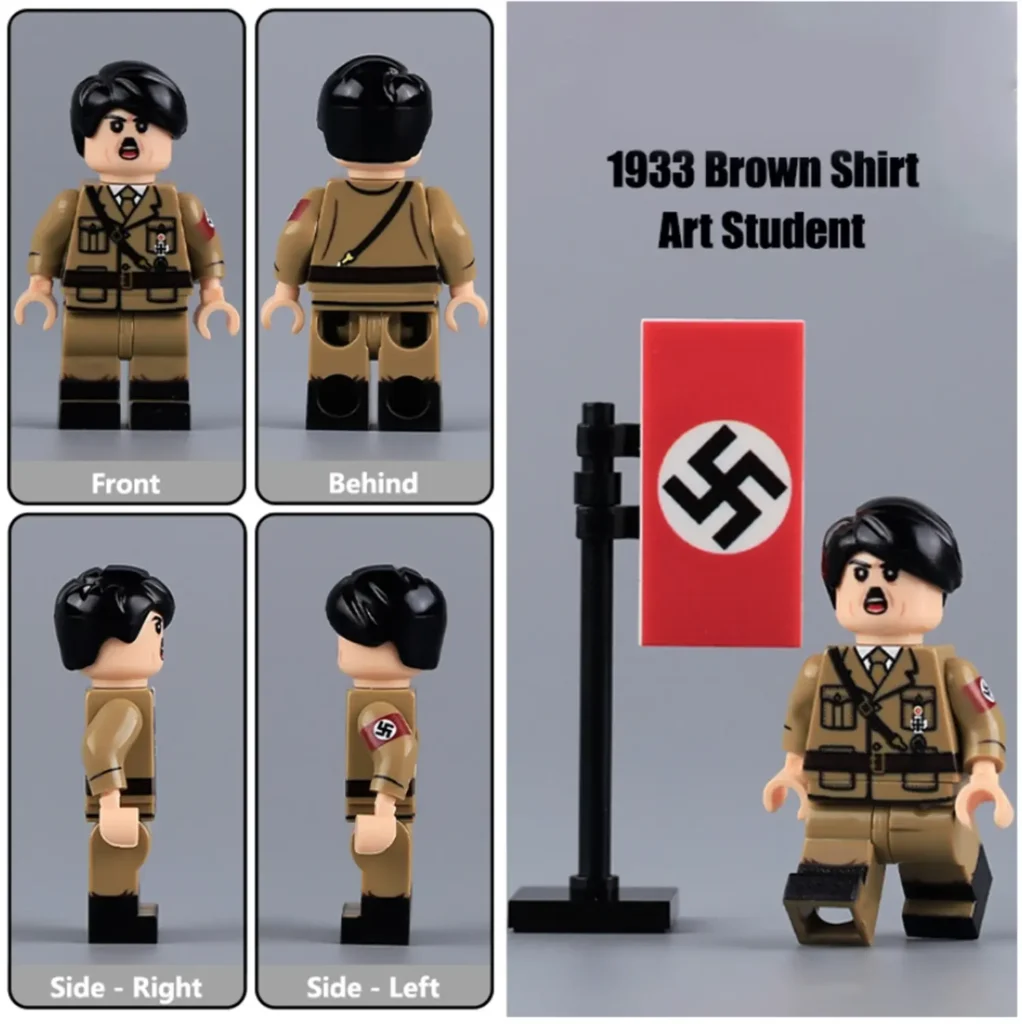
This figure shows Adolf Hitler in the brown shirt political uniform of the Nazi Party (NSDAP). As the Führer (Leader) of the movement, this was his standard attire during his rise to power and was the uniform he wore when he was appointed Chancellor of Germany in 1933. It is famously associated with the party’s paramilitary wing, the SA, who were nicknamed the “Brownshirts.”
Minifigure – Adolf Hitler with formal uniform
Click here to check the product
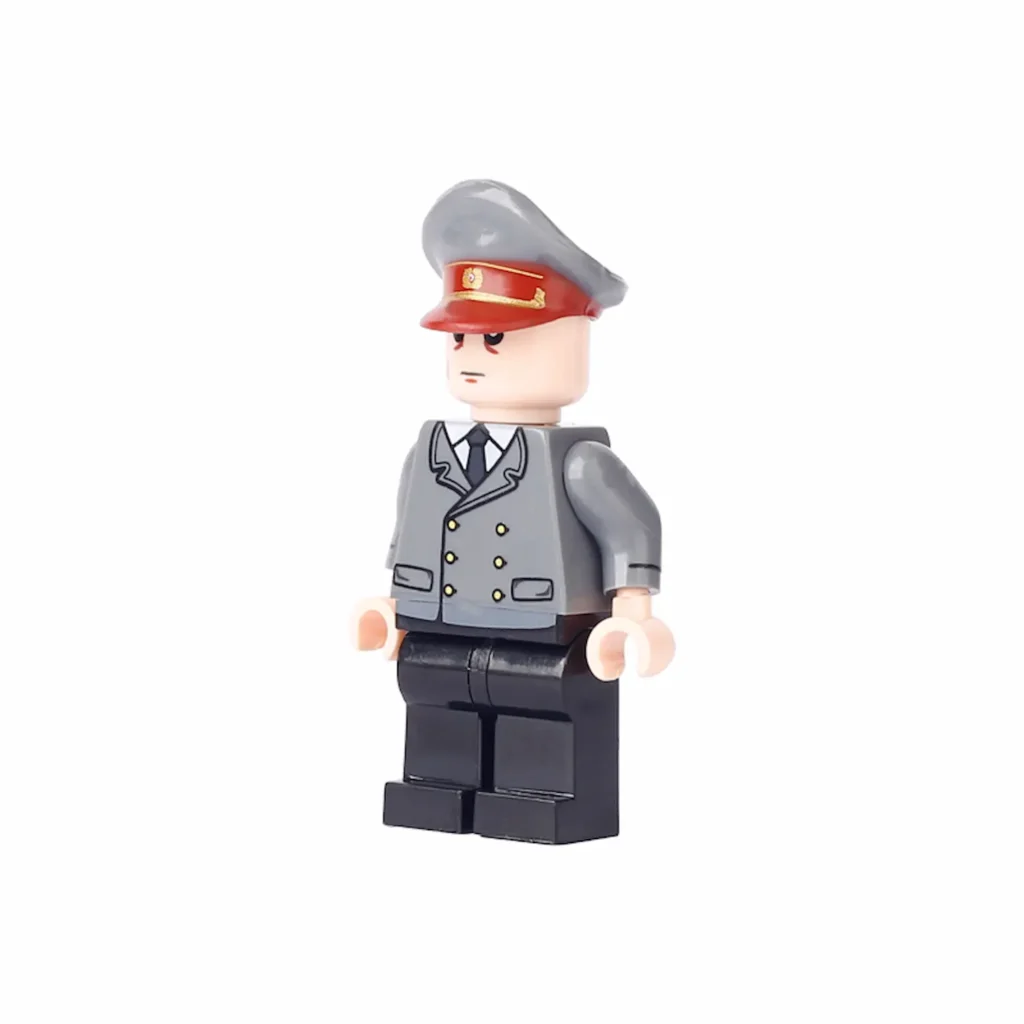
This is the field-gray military-style uniform that Adolf Hitler wore throughout World War II. He adopted it on September 1, 1939, to symbolize his new role as Supreme Commander of the Armed Forces, shifting his public image from a political party leader to Germany’s supreme wartime commander.
Minifigure – Adolf Hitler wearing reading glasses
Click here to check the product
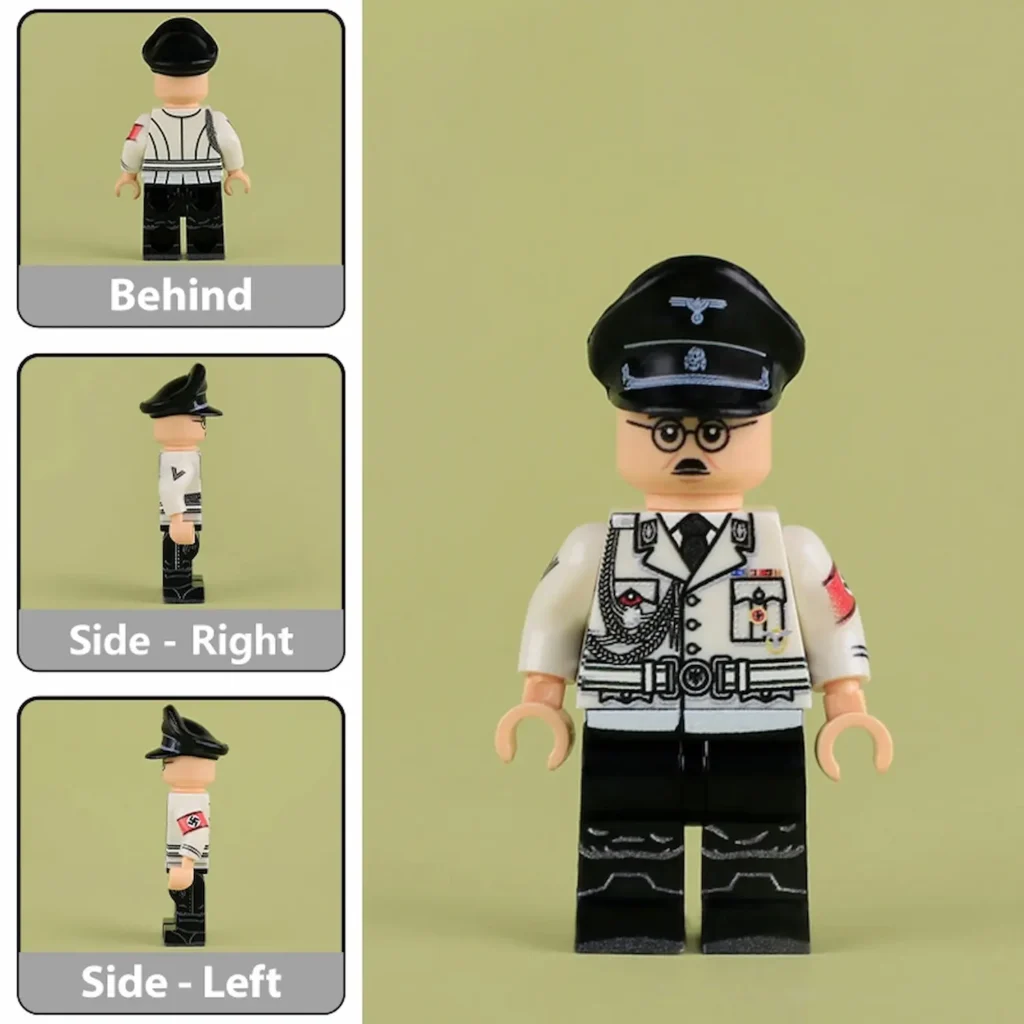
This figure depicts Adolf Hitler in his formal white state uniform. However, he is also wearing reading glasses. Hitler was extremely self-conscious about his glasses and only wore them in private for reading. He banned any public photos of himself wearing them because he felt they made him look weak. So, this toy represents a rare “behind-the-scenes” look, combining his formal uniform with the private accessory he always hid.
Minifigure – Young Adolf Hitler
Click here to check the product

This figure represents Adolf Hitler as a young man, likely from the period of his early political career in Munich (around 1919-1921) or his time as a struggling artist in Vienna just before World War I. This look is significant for what it’s missing: his signature toothbrush mustache and any form of Nazi Party uniform. Instead, he is shown in a simple double-breasted civilian suit, which would have been common attire for him before he deliberately crafted his iconic public image as the Führer with the brown shirt and swastika armband.
How did Adolf Hitler die?
Adolf Hitler died by suicide on April 30, 1945, in his underground air-raid shelter in Berlin, known as the Führerbunker. As Soviet troops advanced and encircled the city, effectively ending the war, Hitler recognized that defeat was inevitable. Refusing to be captured alive, he shot himself in the head. His wife of one day, Eva Braun, died by his side after ingesting a cyanide capsule.
The suicides occurred in Hitler’s private study within the bunker. Just before their deaths, he had poisoned his dog, Blondi, to test the potency of the cyanide. Following Hitler’s explicit prior instructions, his aides carried his and Braun’s bodies up to the garden of the Reich Chancellery, placed them in a bomb crater, doused them with gasoline, and set them on fire. This was done to prevent their bodies from being captured and subjected to a public spectacle by the victorious Soviet forces, similar to what had happened to Italian dictator Benito Mussolini.
How old was Adolf Hitler when he died?
Adolf Hitler was 56 years old when he died. He was born on April 20, 1889, and died by suicide on April 30, 1945, just ten days after his 56th birthday.
How old would Adolf Hitler be today?
If he were still alive today, Adolf Hitler would be 136 years old. He was born on April 20, 1889.
When and where was Adolf Hitler born?
Adolf Hitler was born on April 20, 1889, in Braunau am Inn, a small town in Austria-Hungary, located near the border with the German Empire.
What did Adolf Hitler do?
Adolf Hitler was an Austrian-born German politician who rose to power as the leader (or Führer) of the Nazi Party. Appointed Chancellor of Germany in 1933, he rapidly dismantled the nation’s democratic Weimar Republic and established a totalitarian dictatorship known as the Third Reich. His regime was built on the racist and antisemitic ideology of Nazism. Domestically, he suppressed all political opposition, rebuilt Germany’s military in defiance of international treaties, and implemented policies that severely persecuted German Jews and other marginalized groups.
Hitler’s primary action on the world stage was initiating World War II in Europe with the invasion of Poland in 1939, driven by an expansionist desire to create a “Greater German Reich.” He is most infamously responsible for being the central architect of the Holocaust, the systematic, state-sponsored genocide of six million Jews and millions of other victims, including Romani people, Poles, Soviet civilians and prisoners of war, people with disabilities, and political dissidents. His leadership and actions led directly to the deadliest conflict in history and one of humanity’s most horrific genocides.
Did Adolf Hitler have children?
No, Adolf Hitler had no acknowledged or confirmed children. He was married to Eva Braun for less than 40 hours before their double suicide, and they had no children together. While there have been persistent rumors and claims, most notably from a Frenchman named Jean-Marie Loret, who alleged he was Hitler’s illegitimate son from an affair during World War I, no credible evidence or DNA testing has ever supported this, and the claim is overwhelmingly rejected by mainstream historians.
How did Adolf Hitler rise to power?
Adolf Hitler’s rise to power was a gradual process that exploited the severe political instability, economic hardship, and national humiliation gripping Germany after World War I. After joining the small German Workers’ Party (which he renamed the Nazi Party), he used his powerful oratory skills and propaganda to attract a following. He blamed Germany’s problems on Jews, Communists, and the leaders of the democratic Weimar Republic who had signed the Treaty of Versailles. After a failed attempt to seize power by force in 1923 (the Beer Hall Putsch), he adopted a strategy of gaining power through the legal political system. The catastrophic impact of the Great Depression in 1929 caused mass unemployment and desperation, making his extremist promises of national restoration and economic recovery resonate with millions of voters.
By 1932, the Nazi Party had become the largest party in the German parliament (the Reichstag), creating a political stalemate. Conservative political elites, underestimating Hitler, persuaded President Paul von Hindenburg to appoint him as Chancellor on January 30, 1933, believing they could control him in a coalition government. Hitler immediately and ruthlessly consolidated his power. He used the Reichstag Fire in February 1933 as a pretext to pass an emergency decree that suspended basic civil rights. This was followed by the Enabling Act of 1933, which effectively gave his government the power to legislate without parliament, legally dismantling Germany’s democracy and establishing his totalitarian dictatorship.
How tall is Adolf Hitler?
Based on historical records and army documentation, Adolf Hitler was approximately 5 feet 8 inches tall (about 173 cm).
How did Adolf Hitler kill the jews?
Adolf Hitler’s regime systematically killed six million Jews through a phased and organized genocide now known as the Holocaust. The process began with persecution, stripping Jews of their citizenship and rights through laws like the Nuremberg Laws, and inciting violence like Kristallnacht. After World War II began, this escalated to mass murder. In Eastern Europe, particularly after the invasion of the Soviet Union in 1941, paramilitary death squads called Einsatzgruppen followed the army. Their primary method was rounding up entire Jewish communities, forcing them to dig mass graves, and executing them in mass shootings. Simultaneously, Jews across occupied Europe were forced into overcrowded, sealed ghettos, where they were intentionally deprived of food and medicine, leading to mass death from starvation and disease.
The second, more industrialized phase was the “Final Solution,” formalized at the 1942 Wannsee Conference. This involved the systematic deportation of Jews by train from all over Europe to a network of extermination camps (or “death camps”) built for the sole purpose of mass murder, such as Auschwitz-Birkenau, Treblinka, and Sobibor. Upon arrival, victims were murdered in gas chambers, often disguised as “showers,” using poison gases like Zyklon B or carbon monoxide. Millions were also killed through forced labor (termed “extermination through labor”), starvation, brutal medical experiments, and forced “death marches” as Allied forces closed in at the end of the war.
How did Adolf Hitler find a wife?
Adolf Hitler found his wife, Eva Braun, when she was 17 years old and working as an assistant and model for his personal photographer, Heinrich Hoffmann. They met in Hoffmann’s Munich studio in 1929 and began a relationship, though for most of its duration, Hitler kept her almost entirely hidden from the German public. She lived with him at his Berghof retreat in the Alps but was rarely seen at official events. Their long-term relationship as companions culminated in marriage on April 29, 1945, in the Führerbunker in Berlin, less than 40 hours before they both died by suicide.
How many people did Adolf Hitler kill?
Adolf Hitler’s regime was directly responsible for the systematic, state-sponsored genocide of millions of people. This campaign of mass murder is most known as the Holocaust, which resulted in the deliberate killing of six million Jews. In addition to this, the Nazi regime systematically murdered millions of other civilians and prisoners deemed “undesirable.” These victims included approximately 3.3 million Soviet prisoners of war, 1.8 million non-Jewish Polish civilians, over 270,000 people with disabilities, hundreds of thousands of Romani people, and many other political opponents, homosexuals, and Jehovah’s Witnesses. In total, historians estimate that between 11 and 17 million civilians and prisoners were murdered directly by Hitler’s regime through mass shootings, gassings, starvation, and forced labor.
Beyond those murdered in the genocide, Adolf Hitler was the central figure who initiated World War II in Europe, which became the deadliest conflict in human history. His expansionist military campaigns and racial policies led to the deaths of an estimated 70 to 85 million people worldwide. This staggering figure includes all military and civilian casualties on all sides of the war, including the tens of millions of Soviet and Chinese citizens, as well as German civilians and soldiers. Therefore, Hitler’s direct responsibility for the Holocaust is compounded by his ultimate responsibility for the tens of millions more who died as a result of the war he started.
When and how did Adolf Hitler come to power in Germany?
Adolf Hitler was legally appointed Chancellor of Germany on January 30, 1933. This was the key event that brought him to power. He was not elected directly but was offered the chancellorship by President Paul von Hindenburg, who was persuaded by conservative political elites that Hitler’s popular Nazi Party, the largest in parliament, could be controlled within a coalition government.
However, this appointment did not instantly make him a dictator. Hitler ruthlessly consolidated his power within months. He used the Reichstag Fire in February 1933 as a pretext to pass an emergency decree that suspended civil liberties. This was followed in March by the Enabling Act, which effectively gave his cabinet the power to legislate without parliament, dismantling Germany’s democracy. His power became absolute in August 1934, when President Hindenburg died and Hitler merged the offices of Chancellor and President, declaring himself “Führer and Reich Chancellor.”
Why did Adolf Hitler hate jews?
Adolf Hitler’s hatred of Jews, known as antisemitism, was the fanatical, central core of his entire worldview. He did not invent this hatred but rather absorbed and amplified long-standing anti-Jewish prejudices that had existed in Europe for centuries. His personal ideology, which he outlined in his book Mein Kampf, was built on a pseudoscientific, racist theory that humanity was divided into a hierarchy of races. He viewed the “Aryan race,” which he associated with ethnic Germans, as the “master race” and falsely defined Jews not as a religious group, but as a separate, parasitic, and “inferior” race.
Hitler used this racist ideology to create a convenient and powerful scapegoat for all of Germany’s problems. He falsely blamed the Jews for Germany’s defeat in World War I, claiming they had “stabbed the nation in the back.” He also blamed them for the severe economic crises of the Great Depression, promoting the conspiracy theory that Jews controlled international finance and were working to undermine Germany. In his paranoid worldview, Jews were also the masterminds behind communism (which he called “Jewish Bolshevism”), which he saw as a global conspiracy to destroy the “Aryan” race. This hatred became the driving force of his political movement, unifying his followers and ultimately leading to the Holocaust.
Why did Adolf Hitler start WW2?
Adolf Hitler’s primary motivation for starting World War II was to fulfill the central tenets of Nazi ideology, which were aggressive nationalism, racial supremacy, and the quest for Lebensraum (living space). He believed that the German “Aryan” race was superior and destined to rule, but that it required vast new territories for expansion. This land, he declared, would be taken from the “inferior” Slavic peoples of Eastern Europe, primarily in Poland and the Soviet Union. His entire political and military strategy was built around this goal of creating a “Greater German Reich” that would dominate the continent through racial purification and brutal military conquest.
The war was also a direct result of Hitler’s obsession with reversing Germany’s defeat in World War I and destroying the Treaty of Versailles, which he and many Germans viewed as a national humiliation. After coming to power, he systematically violated the treaty by remilitarizing the army and annexing Austria and Czechoslovakia. The immediate trigger for the war was the invasion of Poland on September 1, 1939. Hitler had demanded Polish territory and, wrongly believing Britain and France would not interfere, he attacked. In response to this act of aggression, which was the clear next step in his expansionist policy, Britain and France honored their alliance with Poland and declared war on Germany, beginning the European conflict.
What did Adolf Hitler do in ww2?
As the absolute dictator of Germany, Adolf Hitler was the central figure who initiated and directed the nation’s war effort. Acting as the supreme commander of the armed forces (Wehrmacht), he was personally involved in planning the key military campaigns, beginning with the successful Blitzkrieg (lightning war) invasions of Poland in 1939 and France in 1940. He made the fateful decision to invade the Soviet Union in 1941 (Operation Barbarossa) and, after early successes, his increasingly erratic and delusional micromanagement, such as his “no retreat” orders, led to catastrophic defeats like the Battle of Stalingrad, which turned the tide of the war in Europe.
Simultaneously, Hitler was the primary architect of the Holocaust, the systematic genocide of European Jews. Throughout the war, he relentlessly pursued his racist ideology, directing the SS and other party organizations to implement the “Final Solution.” This involved forcing Jews into ghettos, using Einsatzgruppen (mobile killing squads) on the Eastern Front, and, finally, establishing a network of extermination camps like Auschwitz. Under his direct authority, six million Jews and millions of other “undesirables”—including Romani people, Poles, Soviet prisoners of war, and people with disabilities—were systematically murdered.
Was Adolf Hitler Jewish?
No, Adolf Hitler was not Jewish. He was born in Austria-Hungary to an Austrian-German family and identified himself as an ethnic German. His entire political ideology and the foundation of the Nazi Party were built upon a fanatical, racist, and virulent antisemitism. He espoused the pseudoscientific belief in an “Aryan master race” and falsely defined Jews as a separate, inferior, and parasitic race that was the source of all Germany’s problems, which became his justification for the Holocaust.
The persistent rumor that Hitler had Jewish ancestry stems from the fact that his paternal grandfather is unknown. Hitler’s father, Alois, was born illegitimately to Maria Anna Schickelgruber. A claim, promoted by Hitler’s personal lawyer Hans Frank after the war, alleged that Maria had been impregnated by a member of a Jewish family named Frankenberger, for whom she supposedly worked as a servant in Graz, Austria. However, mainstream historians and biographers, such as Ian Kershaw and Richard J. Evans, have overwhelmingly rejected this theory. There is no contemporary evidence to support the claim; in fact, historical records indicate there was no Jewish family by that name in Graz at the time, nor is there any proof that Maria Schicklgruber ever lived there. The consensus among historians is that this claim is baseless.
How many assassination attempts were there on Adolf Hitler?
It is impossible to know the exact number, but historians have documented at least 42 separate assassination attempts on Adolf Hitler’s life. These plots came from a wide variety of sources, including lone-wolf individuals, clandestine groups within the German military, and foreign intelligence agencies. Hitler survived all of them, sometimes through sheer luck, last-minute changes to his schedule, or faulty equipment. His survival of so many attempts, particularly the 1944 bomb plot, fed his personal delusion that he was protected by “providence” and destined to complete his mission.
The most famous attempts include the 1939 plot by Georg Elser, a carpenter who single-handedly planted a time bomb in a beer hall pillar where Hitler was scheduled to speak; Hitler left the event minutes before the bomb detonated, which killed eight people. The most significant and well-known conspiracy was the July 20, 1944, plot (Operation Valkyrie), led by Colonel Claus von Stauffenberg. He and other high-ranking military officers planted a briefcase bomb under a conference table at Hitler’s “Wolf’s Lair” headquarters. However, the briefcase was moved behind a heavy wooden table leg, which shielded Hitler from the full blast. He survived with injuries, and the plotters were subsequently rounded up and executed.
What Religion was Adolf Hitler?
Adolf Hitler was born and baptized as a Roman Catholic, and he was confirmed in the Catholic Church as a teenager. Publicly, especially early in his political career, he often framed his mission in religious terms, invoking “Providence” or “the Almighty” in his speeches to appeal to Germany’s large Christian population. His regime signed the Reichskonkordat (Concordat) with the Vatican in 1933, a political treaty that gave his government an air of international legitimacy. He never officially left the Catholic Church, was never excommunicated, and continued to pay his church taxes.
However, in private, Hitler expressed deep-seated hostility towards traditional Christianity, which he derided as a weak, “Jewish-Syllogism” that was incompatible with the “survival of the fittest” principles of National Socialism. His close associates, like Martin Bormann and Joseph Goebbels, documented his private plans to eventually eliminate the influence of the churches in Germany. Most historians conclude that Hitler was not a Christian in any conventional sense; his true belief system was centered on a form of racial mysticism and the deification of the Nazi state, with himself as a messianic figure chosen by “Providence” to lead the “Aryan race.”
Where is Adolf Hitler from?
Adolf Hitler was born on April 20, 1889, in Braunau am Inn, Austria-Hungary, a town that is now part of modern-day Austria, right on the border with Germany. Although he was born an Austrian citizen, he deeply identified as a German nationalist, renounced his Austrian citizenship in 1925, and officially became a citizen of Germany in 1932, which allowed him to run for political office there.
What was Adolf Hitler’s real name?
Adolf Hitler’s real and legal name at birth was indeed Adolf Hitler. The common confusion stems from his father, Alois Hitler, who was born illegitimately in 1837 as Alois Schicklgruber, taking his mother’s surname. However, in 1876, long before Adolf was born, Alois legally changed his surname to Hitler, adopting the name of his presumed-but-unproven biological father (and stepfather), Johann Georg Hiedler. Therefore, when Adolf was born in 1889, his father’s established legal name was Hitler, and “Adolf Hitler” was the name he was given.
Is it illegal to name your kid Adolf Hitler?
In many countries, yes, this would be illegal or at least legally prevented. However, in the United States, it is generally not illegal due to strong First Amendment protections for speech, which extend to naming. While a parent can legally name their child Adolf Hitler, it carries extreme social and potential legal consequences. For example, in a well-known case in New Jersey, a man who named his children “Adolf Hitler” and “Aryan Nation” later had his children removed from his custody. While the name itself was not the sole reason, it was used as significant evidence by the court to demonstrate a pattern of abuse and neglect, proving the parents had created a harmful and dangerous environment for the children.
In many other parts of the world, especially in Europe, the name would be explicitly illegal or rejected by authorities. In Germany and Austria, for instance, laws against glorifying the Nazi regime or using its symbols are very strict, and a court would certainly forbid the name. Other countries, such as France, Sweden, Denmark, and New Zealand, have naming laws that require government registrars to approve all names. Under these systems, a name like “Adolf Hitler” would be swiftly rejected on the grounds that it is profoundly offensive, against the public order, and, most importantly, deeply detrimental to the child’s own welfare and psychological well-being.
What is Adolf Hitler known for?
Adolf Hitler is primarily known as the dictator of Nazi Germany from 1933 to 1945. He was the central figure who initiated World War II in Europe by invading Poland in 1939. His aggressive, expansionist foreign policy, rooted in a racist ideology, led to the deadliest conflict in human history, resulting in the deaths of tens of millions of people. He rose to power as the charismatic leader of the Nazi Party, dismantled German democracy, and established a brutal totalitarian dictatorship known as the Third Reich.
Beyond the war itself, Hitler is most infamously known as the primary architect of the Holocaust. Driven by a fanatical and virulent antisemitism, his regime orchestrated the systematic, state-sponsored genocide of six million Jews. His government also persecuted and murdered millions of other victims, including Soviet prisoners of war, ethnic Poles, Romani people, people with disabilities, and political opponents. His name is synonymous with Nazism, fascism, and the perpetration of one of the most horrific genocides in history.
Is Adolf Hitler a good leader?
This question requires separating the idea of being “effective” from being “good.” From a purely technical standpoint of political mechanics, some historians study Adolf Hitler as a highly effective and charismatic demagogue. He was a masterful public speaker and propagandist who skillfully exploited Germany’s deep economic despair and national humiliation after World War I. He was able to mobilize a mass movement, dismantle a democracy, and consolidate absolute power, convincing millions to follow his vision with fanatical loyalty. In this narrow sense, he was effective at achieving his political aims and uniting a nation, however briefly, behind his goals.
However, by any moral or ethical standard, Adolf Hitler was unequivocally one of the worst and most catastrophic leaders in human history. His leadership was not “good” in any way; it was based on a monstrous ideology of racial hatred, supremacy, and violence. He used his “effectiveness” to perpetrate the Holocaust, the systematic genocide of six million Jews and millions of other victims. He initiated World War II, the deadliest conflict in history, which resulted in the deaths of 70-85 million people and the utter devastation of his own country. His leadership, therefore, was a moral and humanitarian catastrophe that serves as a historical benchmark for evil.
Does Adolf Hitler have any living relatives?
Yes, Adolf Hitler does have a few living relatives, but he has no direct descendants as he and his wife, Eva Braun, had no children. The living relatives are his grand-nephews, descended from his half-siblings. These men are the last of the Hitler bloodline. Three are the sons of Hitler’s nephew, William Patrick Hitler (who changed his family name to Stuart-Houston), and they live in Long Island, New York. The other two are the grandsons of Hitler’s half-sister, Angela Hitler, and they live in Austria.
These men, who are all in their senior years, have intentionally lived their entire lives in obscurity, avoiding all public attention. It is widely reported that the brothers in the United States, and possibly the relatives in Austria, made an unstated pact to never marry or have children. This decision was a deliberate choice to ensure that the Hitler bloodline would end with their generation, extinguishing the infamous lineage for good.
Was Adolf Hitler a dictator?
Yes, Adolf Hitler was the absolute dictator of Germany from 1933 to 1945. He held the title of Führer und Reichskanzler (Leader and Reich Chancellor), which consolidated all state and military power in his hands. Although he was initially appointed Chancellor legally in January 1933, he immediately seized the opportunity of the Reichstag Fire a month later to pass an emergency decree that suspended all basic civil liberties. This was followed in March 1933 by the Enabling Act, a law that effectively gave Hitler’s cabinet the power to legislate without the approval of parliament, thereby dismantling Germany’s democratic republic and making his rule law.
Hitler’s dictatorship was a totalitarian police state. He eliminated all political opposition by banning every other political party, trade union, and independent organization. He enforced his will through a vast apparatus of terror, led by the Gestapo (secret police) and the SS, who imprisoned, tortured, and murdered any perceived enemies of the regime in a network of concentration camps. All media, culture, and education were controlled by Joseph Goebbels’ propaganda ministry, which built a powerful cult of personality around Hitler, whose word was considered the highest law under the “leader principle” (Führerprinzip). This unchecked, absolute authority allowed him to launch World War II and orchestrate the Holocaust.
Was Adolf Hitler a good person?
No, Adolf Hitler was unequivocally not a good person; he is widely regarded as one of the most evil and malevolent figures in human history. His character and actions were defined by a fanatical, racist ideology built on profound hatred, particularly antisemitism. He was the primary architect of the Holocaust, the state-sponsored, systematic genocide of six million Jews. His regime also deliberately murdered millions of other civilians, including Soviet prisoners of war, ethnic Poles, Romani people, people with disabilities, and political opponents, all of whom he deemed “inferior” or “life unworthy of life.”
Furthermore, Hitler was the central figure who initiated World War II in Europe, a war of aggression and conquest that resulted in the deaths of 70 to 85 million people and the devastation of continents. While some sources might note trivial personal traits like his vegetarianism or affection for his dog, these are utterly insignificant when measured against the colossal and unprecedented scale of his crimes. His leadership was a moral catastrophe, and his name is synonymous with genocide, terror, and the ultimate expression of human cruelty.
Was Adolf Hitler a vegetarian?
Whether Adolf Hitler was a strict vegetarian is a an active historical debate, though it is known he followed a vegetarian-style diet for long periods. From 1942 until his death, he publicly identified as a vegetarian, and his propaganda minister, Joseph Goebbels, heavily promoted this image to portray Hitler as a disciplined and ascetic leader. His personal cook, Constanze Manziarly, prepared vegetarian meals for him, and his private secretary, Traudl Junge, noted he “always avoided meat.” His final meal, for instance, was reportedly pasta with tomato sauce.
However, many accounts contradict the claim that he was a strict, life-long vegetarian. Biographers like Robert Payne and Albert Speer, as well as Dione Lucas, a chef who once cooked for him in the 1930s, all stated he had a fondness for meat, including Bavarian sausages, ham, and stuffed squab (pigeon). Some historians argue he only adopted a mostly meat-free diet later in life on his doctor’s orders to treat chronic stomach problems and severe flatulence, not for ethical reasons. Others note that his cook would occasionally add bone marrow or animal broth to his soups, which he would angrily reject if he found out. Therefore, while he primarily ate a vegetarian diet in the final years of his life, there is significant evidence that he was not a consistent, ethically motivated vegetarian.
Was Adolf Hitler gay?
This has been a subject of long-standing speculation, but the overwhelming consensus among mainstream historians and major biographers (such as Sir Ian Kershaw and Joachim Fest) is that Adolf Hitler was heterosexual. Throughout his life, he was exclusively linked romantically with women. His most significant relationship was his long-term affair with Eva Braun, whom he married just before their suicides in 1945. Before her, he had a deeply intense and possessive, though not definitively sexual, relationship with his half-niece, Geli Raubal, whose 1931 suicide devastated him. He was also linked to several other women, including Maria Reiter and Unity Mitford.
The rumors that Hitler was gay or bisexual have several origins. Some were contemporary propaganda spread by his political enemies in the 1920s and 30s to discredit him. These rumors were later fueled by his early, intense friendship with Ernst Röhm, the openly homosexual leader of the SA. However, Hitler ultimately had Röhm and the rest of the SA leadership murdered in the 1934 “Night of the Long Knives,” partly using Röhm’s homosexuality as a public justification for the purge. While a few authors, such as Lothar Machtan in his book The Hidden Hitler, have argued that Hitler was a closeted homosexual, these theories are considered fringe and have been widely dismissed by academic historians for relying on misinterpretations and lacking credible, verifiable evidence.
What country did Adolf Hitler lead?
Adolf Hitler led Germany. He was appointed Chancellor in 1933 and quickly dismantled the country’s democratic republic, establishing a totalitarian dictatorship known as Nazi Germany or the Third Reich. He ruled as the absolute dictator, or Führer (Leader), from then until his death in 1945.
Although he led Germany, it is a common point of confusion that he was not born there. Hitler was born in Austria (then part of Austria-Hungary) in 1889. He was a fervent German nationalist who moved to Germany in 1913, served in the German Army during World War I, and formally acquired German citizenship in 1932, which allowed him to run for high office.
What did Adolf Hitler look like?
Adolf Hitler had a very distinct and, by the end of his life, an infamously recognizable appearance. He was of average height, standing around 5 feet 8 inches (173 cm), with a slight build that became gaunt in his later years. Contrary to the “Aryan” ideal of blond hair and blue eyes that his regime promoted, Hitler had dark brown hair (which he combed over to one side) and intense, piercing blue eyes. Historical accounts describe him as having a pale complexion and being meticulous about his grooming.
His single most defining feature was his “toothbrush” mustache, a small, clipped square of facial hair centered on his upper lip. This style was not unique to him before the war—it was also worn by comedians like Charlie Chaplin—but Hitler’s notoriety made it synonymous with him, and it fell out of fashion globally. He was most often seen in public wearing either a simple, field-gray military-style tunic with a swastika armband, or, less frequently, a civilian suit. As the war progressed, especially after 1941, he was rarely seen in anything but his military uniform, which reinforced his image as Germany’s supreme war leader.
Alright, that’s all for this article for now. Now, I want to hear from you. Do you have any other questions or anything else you’d like to know about Adolf Hitler? Or, perhaps, are there specific toys, figures, or similar items related to him that you’d like to see reviewed? Let me know in the comments section below!






